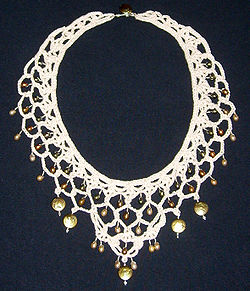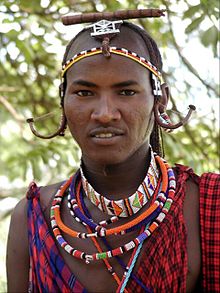- Necklace
-
A necklace is an article of jewellery which is worn around the neck. Necklaces are frequently formed from a metal jewellery chain. Others are woven or manufactured from cloth using string or twine.
Common features of necklaces include features such as colorful stones (particularly gemstones / jewels), wood (usually carved or polished), art glass, feathers, shells, beads or corals - a wide, wide variety of other adornments have also been used. If a necklace includes a primary hanging feature, it is called a pendant or amulet, if the hanging feature is itself a small container, that is called a locket.
Contents
History of necklaces
Necklaces have been an integral part of jewelry since the time of ancient civilizations and predate the invention of writing.
The birth of necklaces is believed to be as old as the Stone Age, which is around 40,000 years old. The oldest necklaces were made of purely natural materials - before weaving and the invention of string, durable vines or pieces of animal sinew left over from hunts were tied together and adorned with shells, bones or teeth or colorful skins of human prey animals, bird feathers, corals, carved pieces of wood, colorful seeds or stones or naturally occurring gems, or other beautiful or artful natural elements found nearby.
Cloth working and metalworking greatly expanded the range of jewelry available to humans. Twine and string enabled the development of smaller, more durable, more intricate necklaces. After the Bronze Age began and humans discovered how to melt metal and cast it into shapes, bronze, copper, silver, gold, electrum, platinum and a variety of other metals were used to make eye-catching necklaces for both men and women, and metal chains became possible. Gemcutting and glassblowing allowed faceted and highly polished gemstones and/or beautiful art glass to be added to pieces.
In the modern era, a variety of new metals are available for necklaces that earlier generations could not properly melt until high-temperature crucibles and blowtorches were developed, such as stainless steel and titanium; electroplating has enabled mass ownership of gold (or at least gold-veneer) jewelry. Miniaturization and laser etching enable the crafting of finely detailed artwork, or insignias or other calligraphy, within individual necklace elements.
Types of necklaces
By length
Women's necklaces are often classified by length.
- Choker
- 35 centimetres (14 in) to 41 centimetres (16 in) long and sits high on the neck.
- Princess necklace
- A princess necklace is 45 centimetres (18 in) to 50 centimetres (20 in) long, longer than a choker, but shorter than a matinee.
- Matinee necklace
- A matinee length necklace is 56 centimetres (22 in) to 58 centimetres (23 in) long - typically a single strand that rests at the top of the cleavage.
- Opera necklace
- An opera necklace is 75 centimetres (30 in) to 90 centimetres (35 in) long and sits at the breastbone.
- Sautoir or rope necklace
- A sautoir or rope necklace is any necklace longer than opera length.
- Lariat necklace
- A lariat is a very, very long variation on the sautoir or rope, without a clasp, often worn draped multiple times around the neck; the ends can be crossed over, looped, or knotted in various ways. This type of necklace sometimes incorporates a loop at one or both ends to allow it to be worn in the style of a lasso, or it may be worn doubled over with the ends passed through the loop formed in the middle.
Men's necklaces do not generally use these terms, though a very short necklace is still known as a choker. Men typically call their necklaces "chains."
By adornment type
- Diamond necklace
- A diamond necklace is a necklace that incorporates diamonds - they are often given as gifts in Western countries as signs of love and fealty between wealthy lovers or families. There are a variety of diamond necklaces available to the average consumer including the diamond eternity necklace, the diamond 'V' necklace, the diamond 'Y' necklace and the diamonds by the yard necklace.[1]
- Pearl necklace
- Pearl necklaces are popular among women. There are two specific named kinds of pearl necklaces - a uniform pearl necklace consists of pearls that appear to be all the same size, although normally there is a slight difference towards the ends so they appear to be in proportion. A bib necklace is made of multiple strands of stepped pearls. Many other variations also exist.
- Tooth pendant necklace
- Some men's necklaces (and a few women's) attach an animal tooth as the pendant portion. A particularly popular variant is a leather string necklace with a shark tooth attached.
- Prayer bead necklace
- Prayer beads, meant to help serve as a focus of meditation or prayer and/or count the recitations or study of religious verses, are sometimes worn in necklace form. Prayer bead necklaces usually contain beads of any kind (often wood beads, seeds or other easily available substances associated with spirituality and/or humility) along their full visible length.
See also
- Affair of the diamond necklace
- Bracelet
- Belly chain
- Bling-bling
- Choker
- Collar
- Figaro chain
- Jewellery chain
- Livery collar
- Love beads
- Omega chain
- Torc
- Necklace splitting problem
- Usekh collar
Notes and references
Jewellery Forms Anklet · Belt buckle · Belly chain · Bindi · Bracelet · Brooch · Chatelaine · Collar pin · Crown · Cufflink · Earring · Lapel pin · Necklace · Pendant · Ring · Tiara · Tie clip · Toe ring · Watch (pocket)Making PeopleProcessesCasting (centrifugal, lost-wax, vacuum) · Enameling · Engraving · Filigree · Metal clay · Plating · Polishing · Repoussé and chasing · Soldering · Stonesetting · Wire wrappingToolsMaterials Britannia silver · Colored gold · Crown gold · Electrum · Platinum sterling · Shakudo · Shibuichi · Sterling silver · TumbagaMineral gemstonesAventurine · Agate · Alexandrite · Amethyst · Aquamarine · Carnelian · Citrine · Diamond · Diopside · Emerald · Garnet · Jade · Jasper · Lapis lazuli · Larimar · Malachite · Marcasite · Moonstone · Obsidian · Onyx · Opal · Peridot · Quartz · Ruby · Sapphire · Sodalite · Sunstone · Tanzanite · Tiger's eye · Topaz · Tourmaline · TurquoiseOrganic gemstonesTerms Categories:- Necklaces
Wikimedia Foundation. 2010.



